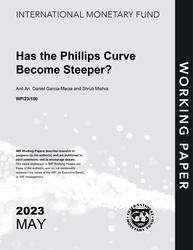
Has the Phillips Curve Become Steeper?
Has the Phillips Curve Become Steeper?
READ MORE...
Volume/Issue:
Volume 2023
Issue 100
Publication date: May 2023
ISBN: 9798400242915
$20.00
Add to Cart by clicking price of the language and format you'd like to purchase
Available Languages and Formats
| English |
Prices in red indicate formats that are not yet available but are forthcoming.
Topics covered in this book
This title contains information about the following subjects.
Click on a subject if you would like to see other titles with the same subjects.
Inflation , Economics- Macroeconomics , Economics / General , Phillips Curve , Inflation , De-globalization , Digitalization , Structural change , POST-pandemic Phillips curve estimation , Phillips curve estimate , price flexibility , Phillips Curve slope , quote data , Output gap , Real effective exchange rates , Europe
Summary
This paper analyzes whether structural changes in the aftermath of the pandemic have steepened the Phillips curves in advanced economies, reversing the flattening observed in recent decades and reducing the sacrifice ratio associated with disinflation. Particularly, analysis of granular price quote data from the UK indicates that increased digitalization may have raised price flexibility, while de-globalization may have made inflation more responsive to domestic economic conditions again. Using sectoral data from 24 advanced economies in Europe, higher digitalization and lower trade intensity are shown to be associated with steeper Phillips curves. Post-pandemic Phillips curve estimates indicate some steepening in the UK, Spain, Italy and the euro area as a whole, but at magnitudes that are too small to explain the entire surge in inflation in 2021–22, suggesting an important role for outward shifts in the Phillips curve.
Copyright © 2010 - 2025
Powered by:
AIDC



